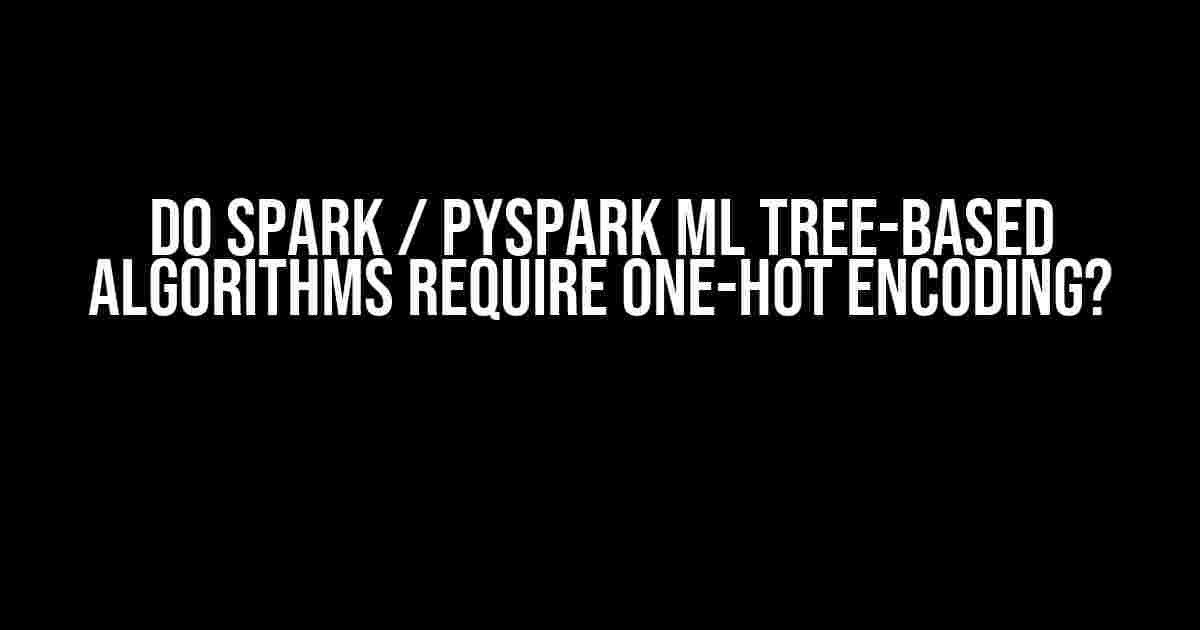Are you delving into the world of machine learning with Spark or PySpark? If so, you’re likely to encounter tree-based algorithms, which are a crucial part of many ML models. But have you ever wondered, “Do Spark / PySpark ML tree-based algorithms require one-hot encoding?”
What are Tree-Based Algorithms?
Before we dive into the question at hand, let’s quickly cover what tree-based algorithms are. Tree-based algorithms are a type of supervised learning algorithm that use decision trees as their core component. These algorithms can be used for both classification and regression tasks. Some popular examples of tree-based algorithms include:
- Decision Trees
- Random Forest
- Gradient Boosting Machines (GBM)
- XGBoost
Tree-based algorithms are powerful because they can handle large datasets, are robust to outliers, and can handle both categorical and numerical features.
What is One-Hot Encoding?
In one-hot encoding, each categorical feature is represented as a binary vector, where all the elements are 0, except for one element, which is 1. This 1 indicates the presence of a particular category. For example, if we have a feature “color” with three categories: red, green, and blue, the one-hot encoding would be:
| Color | Red | Green | Blue |
|---|---|---|---|
| Red | 1 | 0 | 0 |
| Green | 0 | 1 | 0 |
| Blue | 0 | 0 | 1 |
One-hot encoding is commonly used in machine learning because many algorithms, including tree-based algorithms, can’t directly handle categorical features.
Do Spark / PySpark ML Tree-Based Algorithms Require One-Hot Encoding?
Now, let’s get to the question at hand: do Spark / PySpark ML tree-based algorithms require one-hot encoding? The short answer is: it depends.
In Spark ML, tree-based algorithms can handle categorical features natively, without the need for one-hot encoding. This is because Spark ML uses a technique called “categorical indexing” to internally convert categorical features into a numerical representation that can be used by the algorithm.
However, there are some cases where one-hot encoding may still be necessary:
- : When using cross-validation in Spark ML, one-hot encoding may be required because the categorical indexing is not preserved during the cross-validation process.
- Interaction Terms: If you want to include interaction terms between categorical features and other features, one-hot encoding may be necessary.
- Custom Models: If you’re implementing a custom model using Spark ML’s Estimator API, you may need to one-hot encode categorical features depending on the specific requirements of your model.
- PySpark ML: In PySpark ML, one-hot encoding is required for all categorical features, as PySpark ML doesn’t support categorical indexing like Spark ML does.
How to One-Hot Encode Categorical Features in Spark / PySpark ML?
If you do need to one-hot encode categorical features in Spark / PySpark ML, here’s how you can do it:
from pyspark.ml.feature import OneHotEncoder
# assume 'df' is your Spark DataFrame with a categorical feature 'color'
# one-hot encode the 'color' feature
encoder = OneHotEncoder(inputCol="color", outputCol="color_encoded")
encoded_df = encoder.transform(df)
# display the resulting DataFrame
encoded_df.show()
In the code above, we use the `OneHotEncoder` class from PySpark ML to one-hot encode the `color` feature. The resulting encoded feature is stored in a new column called `color_encoded`.
Conclusion
In conclusion, Spark / PySpark ML tree-based algorithms don’t necessarily require one-hot encoding, but there are some cases where it’s necessary. By understanding when and how to use one-hot encoding, you can unlock the full potential of tree-based algorithms in your machine learning models.
Remember, in Spark ML, one-hot encoding is not always necessary, but in PySpark ML, it’s required for all categorical features. By following the instructions outlined in this article, you can one-hot encode categorical features with ease and take your machine learning models to the next level.
So, the next time you’re working with tree-based algorithms in Spark / PySpark ML, don’t forget to consider one-hot encoding for your categorical features. Happy modeling!
Word count: 1066
Frequently Asked Question
Are you wondering if Spark ML tree-based algorithms require one-hot encoding? Well, you’re in the right place! Let’s dive into the answers!
Do Spark ML tree-based algorithms always require one-hot encoding?
Not always! While one-hot encoding can be useful for some tree-based algorithms, it’s not a hard requirement. In fact, some algorithms like Decision Trees and Random Forests can handle categorical variables directly, without the need for one-hot encoding.
What about Gradient Boosting Machines (GBMs)? Do they require one-hot encoding?
Yes, GBMs do require one-hot encoding for categorical variables. This is because GBMs are based on gradient descent, which requires continuous features. One-hot encoding helps to convert categorical variables into a format that can be processed by the GBM algorithm.
Can I use StringIndexer or VectorIndexer instead of one-hot encoding?
Yes, you can! StringIndexer or VectorIndexer can be used as an alternative to one-hot encoding. These transformers convert categorical variables into a numerical representation that can be processed by tree-based algorithms. However, keep in mind that the resulting model might behave slightly differently compared to one-hot encoding.
How do I decide whether to use one-hot encoding or indexing for my categorical variables?
It depends on the specific problem and dataset! If you have a small number of categories with a clear hierarchy, indexing might be a better choice. However, if you have a large number of categories with no clear hierarchy, one-hot encoding might be more suitable. Experiment with both approaches and evaluate the performance of your model to make an informed decision.
Are there any best practices for handling categorical variables in Spark ML?
Yes! When working with categorical variables in Spark ML, it’s essential to handle missing values, encode categorical variables appropriately, and avoid high cardinality features. Additionally, consider using techniques like feature hashing or embedding to reduce dimensionality and improve model performance. Finally, don’t forget to tune hyperparameters and evaluate your model on a holdout set to ensure good generalization.

